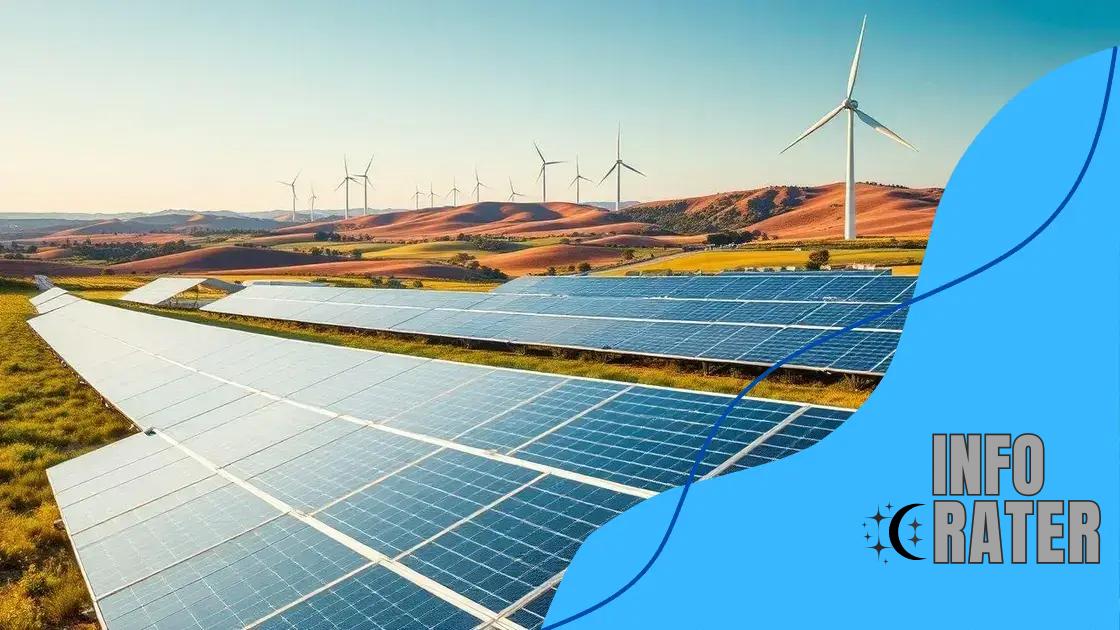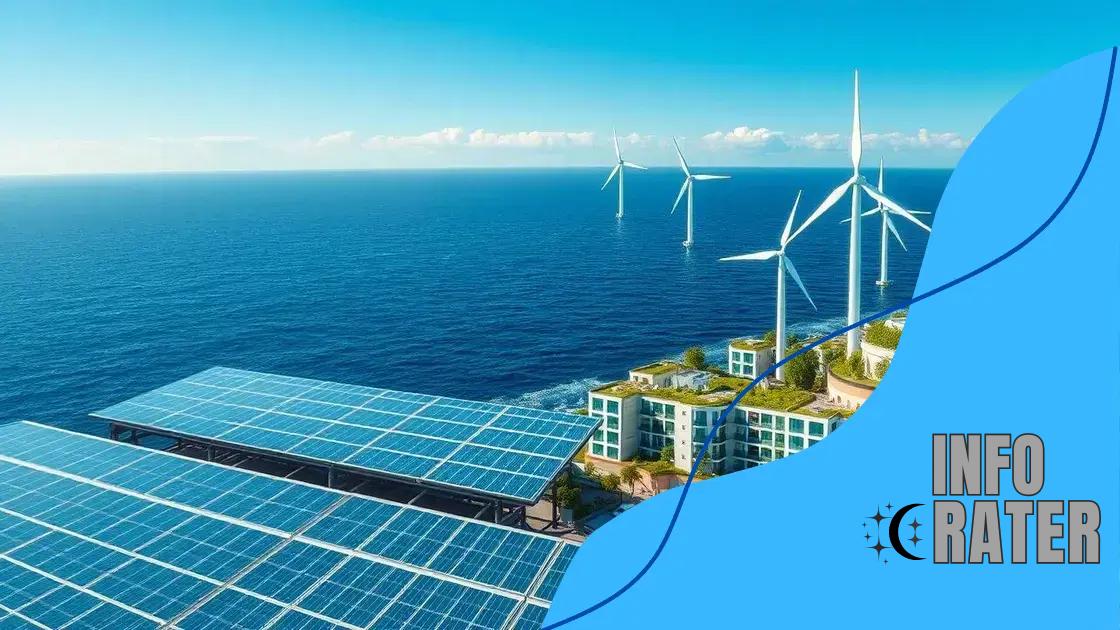Green energy projects reshaping global infrastructure

Green energy projects are transforming global infrastructure by reducing carbon emissions, creating jobs, and promoting sustainable practices through innovative technologies and community engagement.
Green energy projects reshaping global infrastructure are not just a trend; they represent a decisive shift toward sustainability. Have you ever wondered how these initiatives can transform cities and lives worldwide? Dive in to find out more!
Innovative technologies driving green energy
Innovative technologies play a crucial role in green energy development, shaping the way we approach sustainable practices. By harnessing advancements, we can create solutions that not only conserve resources but also enhance efficiency.
Key Technologies in Green Energy
In the realm of green energy, several technologies stand out. These innovations make it possible to use renewable sources effectively, reducing our dependence on fossil fuels.
- Solar Power: The advancement of photovoltaic cells allows us to capture sunlight and convert it into electricity efficiently.
- Wind Energy: Turbines are getting larger and more efficient, making wind a viable source of energy in many regions.
- Energy Storage: Battery technologies like lithium-ion are improving, making it easier to store energy for use when sunlight or wind isn’t available.
- Smart Grids: These systems optimize energy distribution and use, allowing for a more efficient supply chain for renewable energy.
Furthermore, innovations in energy management software are paving the way for smarter consumption. Homeowners can now monitor their energy use in real time, finding ways to save money and reduce waste. These tools empower individuals and businesses alike to participate actively in their energy decisions.
Another exciting development is the rise of bioenergy, which converts organic materials into energy. This can reduce waste and create a sustainable cycle of energy production. Technologies like anaerobic digestion are making bioenergy increasingly efficient.
Challenges and Opportunities
While the advancements in green energy technologies are promising, they do come with challenges. For example, transitioning to renewable energy requires significant investment in infrastructure. However, the long-term benefits, such as job creation and energy independence, can outweigh these initial costs.
As we embrace these innovative approaches, it’s essential to recognize that public policy and community participation are vital for success. Encouraging support for research and development can foster a culture of innovation that drives further advancements.
Economic benefits of green energy projects
The economic benefits of green energy projects are becoming more significant as communities and countries look for sustainable solutions. These projects do more than just help the environment; they also boost local economies and create jobs.
Job Creation
One of the most immediate benefits is the creation of jobs. The green energy sector employs people in various roles, from engineering to installation and maintenance. As more projects develop, the demand for skilled workers increases.
- Renewable Energy Jobs: Jobs in solar, wind, and other renewable sectors are on the rise.
- Manufacturing Opportunities: The need for equipment and materials boosts manufacturing jobs.
- Research and Development: Innovations in green technology create R&D positions.
In addition to direct job opportunities, these projects often lead to an increase in ancillary jobs in areas such as construction and logistics. Communities that invest in green energy see long-term growth potential as they transition to renewable resources.
Another economic advantage involves the reduction of energy costs. As green energy technologies advance, the cost of energy from renewable sources continues to decline. Homeowners and businesses enjoy lower electricity bills, making investments in solar or wind systems worthwhile.
Increased Property Values
The presence of green energy solutions can also raise property values. Homes with solar panels or energy-efficient features are becoming more attractive in the housing market. Buyers are willing to pay more for properties that offer reduced energy costs and a commitment to sustainability.
Moreover, communities that prioritize **green energy** see an influx of businesses looking to establish operations in sustainable locations. Companies increasingly prefer to be associated with environmentally friendly practices, resulting in new investments and consumer interest.
Overall, the movement toward green energy projects presents a win-win scenario: economic growth combined with sustainable practices that benefit our planet. As our dependency on fossil fuels diminishes, the transition creates opportunities and innovations that will shape the economy for years to come.
Case studies of successful projects

Exploring case studies of successful projects in the realm of green energy helps us understand the practical impacts these initiatives have on communities and the environment. These examples demonstrate effective solutions to challenges posed by traditional energy sources.
Highlighted Projects
One notable example is the Solar Star Project in California, which is one of the largest solar farms in the world. This facility generates enough energy to power approximately 255,000 homes. By utilizing over 1.7 million solar panels, Solar Star has significantly contributed to reducing carbon emissions and has set a benchmark for future solar projects.
- Location: Rosamond, California
- Capacity: 579 megawatts
- Impact: Equivalent to removing 400,000 cars from the road
Another inspiring project is the Hornsea One Wind Farm in the UK. This offshore wind farm is a great example of harnessing natural resources to generate clean energy. It produces enough electricity to power over 1 million homes annually.
These successful projects highlight not just the technology used but the potential for economic growth and environmental benefits. By investing in renewable energy, countries can foster job creation and reduce reliance on fossil fuels.
Global Influence
Countries around the world are taking notice of these successes. For instance, Denmark has revolutionized its energy supply through wind energy. Currently, wind power accounts for over 40% of the country’s electricity consumption. This transition has led to a significant drop in greenhouse gas emissions and has positioned Denmark as a global leader in renewable energy.
Furthermore, the Masdar City project in Abu Dhabi is a model for sustainable urban development. This project is designed to be powered entirely by renewable energy, featuring solar and wind solutions throughout the city. Innovative design and planning ensure that Masdar City minimizes its ecological footprint while promoting a clean energy future.
Challenges faced in implementing green energy
Implementing green energy projects comes with a range of challenges that can hinder progress. While the benefits are clear, addressing obstacles is crucial for successful deployment.
High Initial Costs
One of the primary challenges is the high initial investment required for many renewable energy technologies. Solar panels, wind turbines, and energy storage systems can be expensive to install. This can make it difficult for small businesses and homeowners to adopt green solutions.
- Financing Options: Without good financing solutions, many potential projects may not start.
- Government Incentives: Lack of subsidies can discourage investment.
- Public Perception: Misunderstandings about costs can cause hesitance in adoption.
As a result, promoting financial incentives, such as tax credits and grants, is key to overcoming these barriers.
Intermittency of Energy Sources
Another significant challenge involves the intermittency of renewable energy sources. For instance, solar energy is abundant on sunny days but can be limited during cloudy weather or at night. Similarly, wind energy is not always available when demand is high.
This variability requires advanced grid management and energy storage solutions. Integrating smart grids and improving battery technologies can help ensure a stable energy supply.
Regulatory Hurdles
Navigating regulations and standards is also a hurdle in implementing green energy projects. Different regions have various policies that can either support or hinder renewable energy development. Inconsistent regulations may lead to confusion and delay projects.
Strong collaboration between governments and private sectors can simplify this process. Developing clear policies can make it easier for both developers and consumers to understand their options.
Additionally, community acceptance plays a vital role in the successful adoption of green energy projects. Local opposition to wind farms or solar installations can slow down progress, highlighting the need for education and outreach.
Future trends in global green infrastructure
Future trends in global green infrastructure are shifting rapidly as technology and awareness grow. As cities strive to become more sustainable, innovative practices and designs are emerging.
Smart Cities Development
One major trend is the rise of smart cities that integrate technology into their infrastructure. These cities use sensors and data analytics to optimize energy usage, waste management, and transportation.
- Energy Efficiency: Buildings equipped with smart technologies can monitor and adjust energy consumption.
- Traffic Management: Intelligent traffic systems reduce congestion and emissions.
- Public Engagement: Apps and platforms allow citizens to participate in sustainability initiatives.
This integration of technology helps create a more resilient urban environment, making it easier to manage resources efficiently.
Increased Use of Renewable Materials
Another trend is the use of sustainable materials in construction. Developers are focusing on renewable resources that minimize environmental impact. For instance, bamboo and recycled materials are gaining popularity.
This shift not only reduces waste but also supports a circular economy where materials are reused and repurposed. Embracing these alternatives can lead to lower carbon footprints in building projects.
Decentralized Energy Systems
Decentralized energy systems are also on the rise. Instead of relying solely on large-scale power plants, communities are exploring local energy solutions, like microgrids and community solar projects. These systems promote energy independence and reduce transmission losses.
Energy storage technologies, such as advanced batteries, will play an essential role in this transformation by making it possible to store excess energy generated from renewable sources.
The collaboration between public and private sectors will be crucial to drive these trends forward. With investment in research and development, more effective green solutions can be created, paving the way for a sustainable future.
FAQ – Frequently Asked Questions about Green Energy Projects
What are the main benefits of green energy?
The main benefits of green energy include reducing carbon emissions, promoting sustainable practices, and creating jobs in the renewable energy sector.
How do renewable energy projects create jobs?
Renewable energy projects create jobs in various areas, including manufacturing, installation, maintenance, and research and development, helping boost local economies.
What challenges do green energy projects face?
Some challenges include high initial costs, regulatory hurdles, and the intermittency of energy supply from sources like solar and wind.
What trends are shaping the future of green infrastructure?
Future trends include the development of smart cities, increased use of renewable materials, and the rise of decentralized energy systems.





